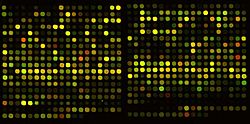I learned what CDNA is in the following paragraph. (To better understand all this drill down yourself through the word buttons in this paragraph if you are interested).
begin partial quote from:
DNA chips
A DNA microarray (also commonly known as DNA chip or biochip) is a collection of microscopic DNA spots attached to a solid surface. Scientists use DNA microarrays to measure the expression levels of large numbers of genes simultaneously or to genotype multiple regions of a genome. Each DNA spot contains picomoles (10−12 moles) of a specific DNA sequence, known as probes (or reporters or oligos). These can be a short section of a gene or other DNA element that are used to hybridize a cDNA or cRNA (also called anti-sense RNA) sample (called target) under high-stringency conditions. Probe-target hybridization is usually detected and quantified by detection of fluorophore-, silver-, or chemiluminescence-labeled targets to determine relative abundance of nucleic acid sequences in the target. The original nucleic acid arrays were macro arrays approximately 9 cm × 12 cm and the first computerized image based analysis was published in 1981.[1]
begin quote from:
cDNA
Complementary DNA
From Wikipedia, the free encyclopedia
(Redirected from CDNA)
"CDNA" redirects here. For the football club, see CSKA Sofia. For the C form of DNA, see C-DNA.
For the general property of complementarity in molecular biology, see Complementarity (molecular biology). For complementation tests used in genetics research, see Complementation (genetics).
| This article needs additional citations for verification. (October 2010) (Learn how and when to remove this template message) |
Output from a cDNA microarray used in testing
The term cDNA is also used, typically in a bioinformatics context, to refer to an mRNA transcript's sequence, expressed as DNA bases (GCAT) rather than RNA bases (GCAU).
The number of introns present in a cDNA is zero, since it is derived from eukaryotic mRNA which does not contain introns (polycistronic).
Contents
Synthesis
Although there are several methods for doing so, cDNA is most often synthesized from mature (fully spliced) mRNA using the enzyme reverse transcriptase. This enzyme, which naturally occurs in retroviruses, operates on a single strand of mRNA, generating its complementary DNA based on the pairing of RNA base pairs (A, U, G and C) to their DNA complements (T, A, C and G, respectively).To obtain eukaryotic cDNA whose introns have been removed:
- A eukaryotic cell transcribes the DNA (from genes) into RNA (pre-mRNA).
- The same cell processes the pre-mRNA strands by removing introns, and adding a poly-A tail and 5’ Methyl-Guanine cap (this is known as post-transcriptional modification)
- This mixture of mature mRNA strands is extracted from the cell. The Poly-A tail of the post-transcription mRNA can be taken advantage of with oligo(dT) beads in an affinity chromatography assay.
- A poly-T oligonucleotide primer is hybridized onto the poly-A tail of the mature mRNA template, or random hexamer primers can be added which contain every possible 6 base single strand of DNA and can therefore hybridize anywhere on the RNA (Reverse transcriptase requires this double-stranded segment as a primer to start its operation.)
- Reverse transcriptase is added, along with deoxynucleotide triphosphates (A, T, G, C). This synthesizes one complementary strand of DNA hybridized to the original mRNA strand.
- To synthesize an additional DNA strand, traditionally one would digest the RNA of the hybrid strand, using an enzyme like RNase H, or through alkali digestion method.
- After digestion of the RNA, a single stranded DNA (ssDNA) is left and because single stranded nucleic acids are hydrophobic, it tends to loop around itself. It is likely that the ssDNA forms a hairpin loop at the 3' end.
- From the hairpin loop, a DNA polymerase can then use it as a primer to transcribe a complementary sequence for the ss cDNA.
- Now, you should be left with a double stranded cDNA with identical sequence as the mRNA of interest.
Applications
Complementary DNA is often used in gene cloning or as gene probes or in the creation of a cDNA library. When scientists transfer a gene from one cell into another cell in order to express the new genetic material as a protein in the recipient cell, the cDNA will be added to the recipient (rather than the entire gene), because the DNA for an entire gene may include DNA that does not code for the protein or that interrupts the coding sequence of the protein (e.g., introns). Partial sequences of cDNAs are often obtained as expressed sequence tags.With amplification of DNA sequences via polymerase chain reaction (PCR) now commonplace, one will typically conduct reverse transcription as an initial step, followed by PCR to obtain an exact sequence of cDNA for intra-cellular expression. This is achieved by designing sequence-specific DNA primers that hybridize to the 5' and 3' ends of a cDNA region coding for a protein. Once amplified, the sequence can be cut at each end with nucleases and inserted into one of many small circular DNA sequences known as expression vectors. Such vectors allow for self-replication, inside the cells, and potentially integration in the host DNA. They typically also contain a strong promoter to drive transcription of the target cDNA into mRNA, which is then translated into protein.
On June 13, 2013, the United States Supreme Court ruled in the case of Association for Molecular Pathology v. Myriad Genetics that while naturally occurring human genes cannot be patented, cDNA is patent eligible because it does not occur naturally. [2]
Viruses
Some viruses also use cDNA to turn their viral RNA into mRNA (viral RNA → cDNA → mRNA). The mRNA is used to make viral proteins to take over the host cell.See also
References
- Liptak, Adam (13 June 2013). "Supreme Court Rules Human Genes May Not Be Patented". The New York Times. Retrieved 14 June 2013.

No comments:
Post a Comment